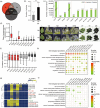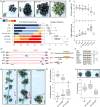Engineering homoeologs provide a fine scale for quantitative traits in polyploid
- PMID: 37530518
- PMCID: PMC10651150
- DOI: 10.1111/pbi.14141
Engineering homoeologs provide a fine scale for quantitative traits in polyploid
Abstract
Numerous staple crops exhibit polyploidy and are difficult to genetically modify. However, recent advances in genome sequencing and editing have enabled polyploid genome engineering. The hexaploid black nightshade species Solanum nigrum has immense potential as a beneficial food supplement. We assembled its genome at the scaffold level. After functional annotations, we identified homoeologous gene sets, with similar sequence and expression profiles, based on comparative analyses of orthologous genes with close diploid relatives Solanum americanum and S. lycopersicum. Using CRISPR-Cas9-mediated mutagenesis, we generated various mutation combinations in homoeologous genes. Multiple mutants showed quantitative phenotypic changes based on the genotype, resulting in a broad-spectrum effect on the quantitative traits of hexaploid S. nigrum. Furthermore, we successfully improved the fruit productivity of Boranong, an orphan cultivar of S. nigrum suggesting that engineering homoeologous genes could be useful for agricultural improvement of polyploid crops.
Keywords: agricultural improvement; homoeologous gene editing; polyploid; quantitative traits.
© 2023 The Authors. Plant Biotechnology Journal published by Society for Experimental Biology and The Association of Applied Biologists and John Wiley & Sons Ltd.
Conflict of interest statement
The authors declare no competing interests.
Figures






References
-
- Andrés, F. and Coupland, G. (2012) The genetic basis of flowering responses to seasonal cues. Nat. Rev. Genet. 13, 627–639. - PubMed
-
- Bernard, R.L. (1972) Two genes affecting stem termination in soybeans 1. Crop. Sci. 12, 235–239.
-
- Comai, L. (2005) The advantages and disadvantages of being polyploid. Nat. Rev. Genet. 6, 836–846. - PubMed
-
- Doyle, J.J. and Doyle, J.L. (1987) A rapid DNA isolation procedure for small quantities of fresh leaf tissue. Phytochem. Bull. 19, 11–15.
Publication types
MeSH terms
Grants and funding
LinkOut - more resources
Full Text Sources

